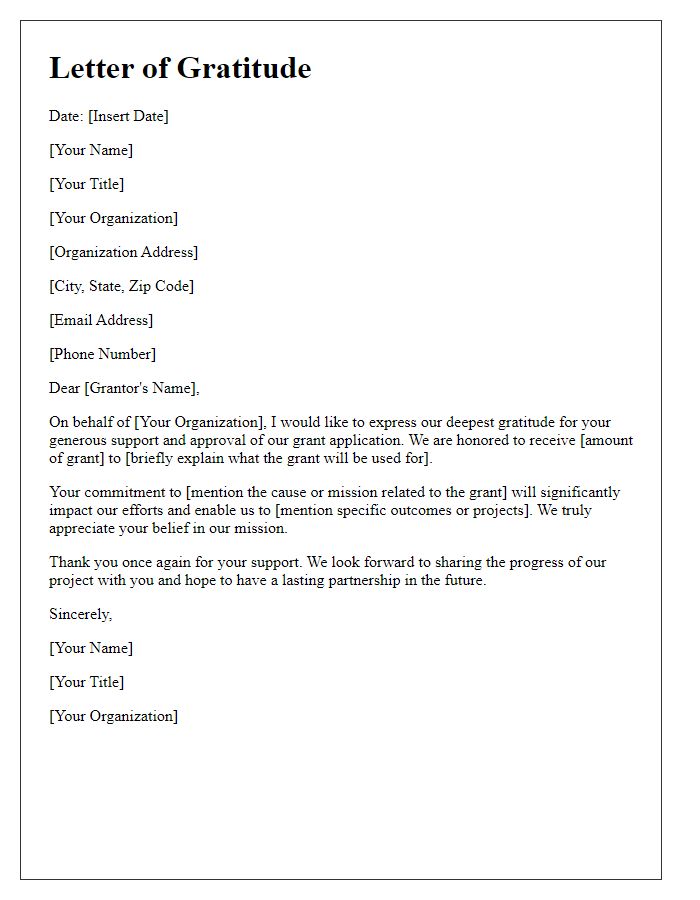Congratulations! We are thrilled to inform you that your grant application has been accepted. This opportunity not only supports your remarkable work but also highlights the importance of your mission in the community. We invite you to continue reading to discover the details of the grant and how it will make a difference in achieving your goals.

Confirmation of acceptance
The grant acceptance letter signifies the agreement between an organization and a funding body, typically specifying the grant amount, project timelines, and stipulations for fund usage. This well-structured document underscores the commitment to the shared goals of improving community welfare or advancing specific causes, such as education or health. It often includes details about the grant's financial provisions (e.g., a total of $50,000 allocated for a three-year period), alongside the critical milestones expected to be reported to the funder throughout the project duration. Adhering to the ethical guidelines outlined, the letter assures transparency and accountability, reinforcing the organization's responsibility to utilize the resources effectively for the intended beneficiaries, enhancing the impact of the funded initiatives.
Expression of gratitude
Charitable organizations often express their gratitude following the acceptance of a grant. An effective expression of gratitude enhances relationships with grantors and reflects the mission of the organization. In this context, it's common to detail the specific grant amount, describe the project it supports, and outline the anticipated impact on the community. Recognition of the grantor's commitment to social change or community development reinforces the partnership ethos. Additionally, sharing ongoing plans to communicate progress or outcomes can strengthen future collaboration and accountability. Such letters usually emphasize appreciation without requiring further expectations from the grantor.
Project details and goals
The initiative aims to provide educational resources and training programs for underprivileged children in urban areas. The project, named "EmpowerEd," will focus on three key objectives: enhancing literacy rates among children ages 6-12, providing computer skills training for at least 200 students, and establishing after-school mentorship programs in partnership with local educational institutions. The program will be launched in three major cities: Los Angeles, Chicago, and New York, targeting neighborhoods with high poverty rates exceeding 30%. The expected outcome includes a 15% increase in reading comprehension and digital literacy within the first year, along with greater youth engagement in academic and extracurricular activities. Local volunteers and educators from structured partnerships will facilitate workshops, ensuring a sustainable impact on the community's educational landscape.
Funding utilization plan
A comprehensive funding utilization plan outlines the strategic allocation of financial resources to maximize impact on community initiatives. For instance, grant funds totaling $50,000 will be allocated towards essential programs such as educational outreach in underprivileged neighborhoods of Chicago, where over 25% of residents live below the poverty line. Specifically, $20,000 will support after-school tutoring services aimed at boosting literacy rates among children aged 6-12. An additional $15,000 will facilitate workshops on financial literacy for adults in communities like Englewood, where unemployment rates are significantly higher than the national average. The remaining $15,000 will be reserved for administrative costs, ensuring that all programs operate efficiently while maintaining compliance with grant requirements. This plan emphasizes a commitment to transparency and accountability, providing regular updates to stakeholders on the progress and outcomes of funded initiatives.
Contact information for future correspondence
Accepting a charity grant represents a significant step forward for organizations, particularly those focused on social causes. Detailed records of contact information, which include the name of the recipient organization, mailing addresses, phone numbers, and email addresses, are essential for future correspondence regarding grant utilization. This information ensures transparency throughout the fund distribution process. Notably, entities such as government agencies or private foundations often require periodic updates and reports about the progress of funded projects, thus necessitating these accurate contact details. Proper documentation assists in fostering strong relationships with donors, enabling further support and collaboration in upcoming initiatives.













Comments